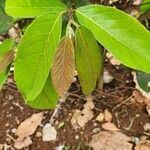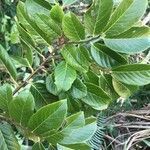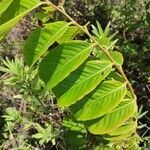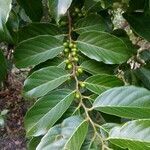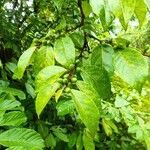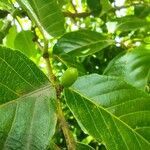Perennial tree or shrub, 2-20 m high; deciduous, much branched, trunk and branches with scattered blunt thorns, wood hard, twigs lenticellate; young shoots and petioles evenly to sparingly pubescent or subglabrous. Leaves elliptic to elliptic-oblong, shortly obtuse-acuminate, base rounded to cuneate, Sub-Entire or shallowly crenate, thinly coriaceous. Stipules linear-lanceolate, puberulous or pubescent. Male flowers: pedicels sparingly appressed-puberulous; sepals triangular-ovate, acute, glabrous within; petals obtriangular, apically tridentate, shallowly 5-lobed, glabrous; filaments narrowing apically. Female flowers faintly scented, subsessile or with short, stout pedicels; sepals triangular; petals elliptic, Sub-Entire; ovary ovoid-subglobose, 2-or 3-celled; styles free, bifid, stigmas smooth. Fruit ellipsoid or occasionally subglobose. Seeds smooth, slightly shiny.
A deciduous tree. It grows up to 21 m tall. It has a wide leafy crown. The trunk is grey-brown. It is smooth when young but rough when older. The twigs are knobbly and covered with small scattered raised brown dots. The leaves are simple and slightly wavy. They are oval and have a point at the end. The base is narrowed or rounded. The leaves are 4-18 cm long and 2.5-10 cm wide. There are 8-15 pairs of veins. The veins and midrib are raised under the leaf. The leaves are on short robust leaf stalks. Young leaves are red. The male and female flowers occur on the same tree. The male flowers have stalks and the female flowers have no stalks. The flowers are white in in clusters in the axils of leaves. The fruit are small and oval. They are black when ripe and 10 mm long by 7 mm wide. They are edible.
Leaf blades 3–28 × 1.5–12 cm, elliptic to elliptic-oblong, shortly obtusely acuminate, rounded to cuneate at the base, subentire or very shallowly crenate, thinly coriaceous, sparingly pubescent to subglabrous along the midrib and main nerves above and beneath and otherwise ± glabrous above and minutely sparingly appressed-puberulous beneath, carmine-orange in young flush, dark or bright green and shiny above and paler below, with the nerves often pale yellow when mature, often drying greenish-grey above and light brown beneath; lateral nerves in 5–20 pairs, craspedodromous, slightly prominent above and beneath or somewhat more so beneath, tertiary nerves parallel or subparallel, not prominent.
Male flowers: pedicels 1 mm long, sparingly appressed-puberulous; sepals 2 × 1 mm, triangular-ovate, acute, appressed-puberulous without, glabrous within, greenish; petals 0.5 × 0.5 mm, obtriangular, apically tridentate, greenish-white; disk 2 mm in diameter, shallowly 5-lobed, ± flat, fleshy, glabrous; staminal column 1 mm high; filaments 0.5 mm long, narrowing apically; anthers 0.75 mm long, yellow; pistillode 0.5 mm tall, ± conical, shallowly lobed at the apex.
Female flowers faintly scented, subsessile or shortly stoutly pedicellate; sepals triangular, pale grey-green, otherwise ± as in the male; petals 1 × 0.5 mm, elliptic, subentire; outer disk 1.5 mm in diameter, pentagonal; inner disk 3-lobed, the lobes erose at the apex, closely enfolding the ovary, reddish-brown; ovary c. 0.75 × 0.75 mm, ovoid-subglobose, 2–3-celled; styles 2–3, c. 0.75 mm long, ± free, bifid, stigmas smooth.
Tree, up to 15 m high. Leaves glabrous, apex shortly attenuate, elliptic to obovate, usually 70-80 x 35-40 mm, dark glossy green above, paler below, iateral veins terminating in margin. Flowers yellow.
An evergreen or deciduous, often much-branched, small tree up to 20 m high with a dense spreading crown and ± flattened or pendent branches arising from c. 2 m above ground.
Fruit 6–8 × 4–5 mm when dried, slightly larger when fresh, ellipsoid or occasionally subglobose, 1-locular by abortion, green at first, black when ripe.
Bark smooth and pale grey or pinkish-brown on branches, rough and dark grey or brown at base of trunk.
Stipules 4–7 mm long, linear-lanceolate, acute, puberulous or pubescent.
Young shoots and petioles evenly to sparingly pubescent or subglabrous.
Shrub or tree, to 60 ft. high, with a dense widely spreading crown
Trunk and branches with scattered blunt thorns.
Seeds 5 × 3 mm, smooth, slightly shiny, brown.
Twigs dark grey or brown, lenticellate.
Petioles 5–13 mm long.
Branches often spiny
Wood hard, white.
